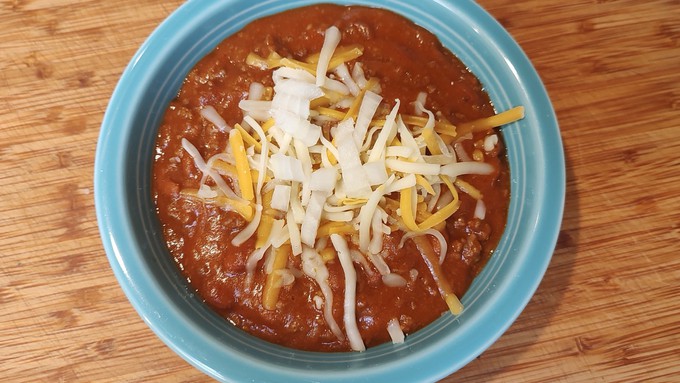
Recipe: Mom’s chili and beans with grated cheese and onions

Warm up on a late winter night with chili and beans, made with last summer's tomatoes (or purchased canned tomatoes). Debbie Arrington
On cold nights, I crave something warm, a little spicy and spiked with memories. Namely, I want my grandmother’s chili and beans.
I watched Mom (what everybody in our extended family called my grandmother) make this chili from scratch many times before I finally coaxed from her the recipe. Then, I committed it to memory.
I make my version with home-grown tomatoes and tomato sauce, preserved in my freezer, and dried pintos, cooked in the InstantPot. (Winter is dried bean season, after all.)
Canned tomatoes or beans may be substituted. (Use the 15-ounce size of each.) But home-grown tomatoes (even frozen) remind me of summer’s delicious bounty.
Chili isn’t just for dinner (or lunch). Leftover chili makes a wonderful and hearty omelet.
Mom’s chili and beans
Makes 4 large servings
Ingredients:
1 pound ground beef
1 large yellow onion, chopped
2 cloves garlic, minced
2 tablespoons flour
1 tablespoon chili powder
2 teaspoons ground cumin
1 teaspoon red chili flakes
Salt to taste (about 2 teaspoons)
2 cups whole tomatoes with juice
1 cup tomato sauce
2 cups cooked pinto beans with ½ cup cooking liquid
Additional water as needed
Grated cheese (optional)
Chopped onions (optional)
Instructions:
In a large heavy pot over medium heat, brown the ground beef. As it cooks, add chopped onion and minced garlic and let them soften in the meat’s juices. Once the meat is cooked and the onions are soft, pour off any excess fat.
Add flour, chili powder, cumin, chili flakes and salt to meat-onion mixture; stir until combined.
Add tomatoes with juice, tomato sauce and beans with liquid. Stir well.
Raise heat and bring mixture to a boil. Cover pot and reduce heat. While stirring occasionally to prevent sticking, let mixture simmer until flavors are well combined, at least 30 to 45 minutes. Add water as needed so chili doesn’t get too thick. Adjust seasoning.
Serve hot, topped with grated cheese and chopped onions if desired.
Comments
0 comments have been posted.Sacramento Digs Gardening to your inbox.
Sites We Like
Garden Checklist for week of May 12
Get your gardening chores and irrigation done early in the day before temperatures rise.
* Plant, plant, plant! It’s prime planting season in the Sacramento area. Time to set out those tomato transplants along with peppers and eggplants. Pinch off any flowers on new transplants to make them concentrate on establishing roots instead of setting premature fruit.
* Direct-seed melons, cucumbers, summer squash, corn, radishes, pumpkins and annual herbs such as basil.
* Harvest cabbage, lettuce, peas and green onions. This heat will cause leafy greens and onions to flower; pick them before they bolt.
* In the flower garden, direct-seed sunflowers, cosmos, salvia, zinnias, marigolds, celosia and asters.
* Plant dahlia tubers. Other perennials to set out include verbena, coreopsis, coneflower and astilbe.
* Transplant petunias, marigolds and perennial flowers such as astilbe, columbine, coneflowers, coreopsis, dahlias, rudbeckia and verbena.
* Keep an eye out for slugs, snails, earwigs and aphids that want to dine on tender new growth.
* Feed summer bloomers with a balanced fertilizer.
* For continued bloom, cut off spent flowers on roses as well as other flowering plants.
* Got fruit trees? If you haven't already done so, thin orchard fruit such as apples, peaches, pears, pluots and plums before they grow too heavy, breaking branches or even splitting the tree. Leave the largest fruit on the branch, culling the smaller ones, and allow for 5 to 6 inches (or a hand's worth) between each fruit.
* Thin grape bunches, again leaving about 6 inches between them. For the remaining bunches, prune off the "tail" end, about the bottom third of the bunch, so that the plant's energy is concentrated in the fruit closest to the branch.
* As spring-flowering shrubs finish blooming, give them a little pruning to shape them, removing old and dead wood. Lightly trim azaleas, fuchsias and marguerites for bushier plants.
* Add mulch to the garden to help keep that precious water from evaporating. Mulch also cuts down on weeds. But don’t let it mound around the stems or trunks of trees or shrubs. Leave about a 6-inch to 1-foot circle to avoid crown rot or other problems.